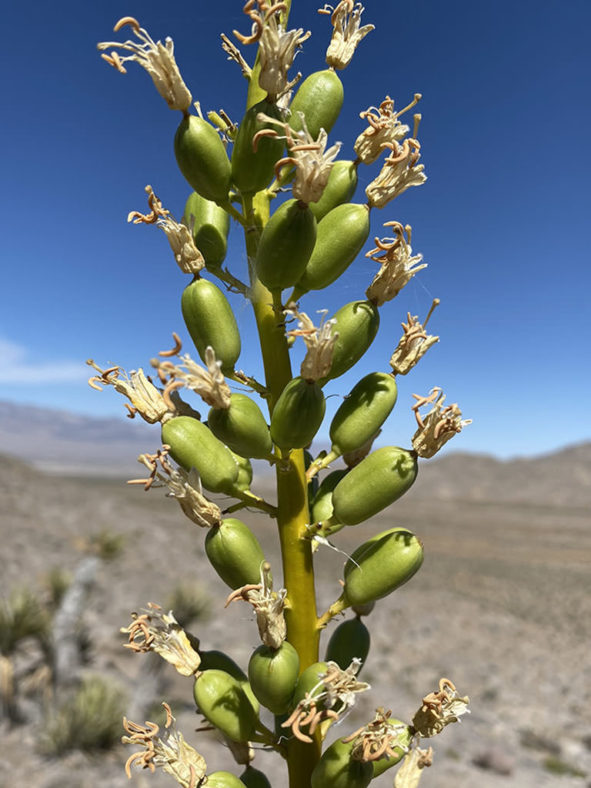Scientific Name
Agave utahensis var. nevadensis Engelm. ex Greenm. & Roush
Common Name(s)
Clark Mountain Agave, Nevada Agave
Synonym(s)
Agave nevadensis
Scientific Classification
Family: Asparagaceae
Subfamily: Agavoideae
Genus: Agave
Etymology
The varietal epithet "nevadensis (nev-uh-DEN-sis)" means "of or from Nevada" and refers to Nevada, a state in the Western region of the United States where this variety occurs naturally.
Origin
Agave utahensis var. nevadensis is native to the United States (Nevada and California). It occurs in desert scrub to conifer woodlands on calcareous outcrops in the montane Mojave Desert at elevations ranging between 3,900 and 6,200 feet (1,200 and 1,900 m).
Description
Agave utahensis var. nevadensis is a small, ornamental succulent that forms rosettes of blue-green leaves with strong marginal teeth and a long brown to whitish terminal spine. It is one of the smallest species of the genus Agave. The rosettes can grow up to 10 inches (25 cm) in diameter. The leaves are linear–lanceolate with a flat to slightly concave upper surface and a convex lower surface. They can measure up to 10 inches (25 cm) long and up to 1.2 inches (3 cm) wide. The terminal spine can grow up to 3.2 inches (8 cm) long.
The yellow, urn-shaped flowers appear on an open to densely flowered inflorescence from late winter to early summer. They can reach up to 1 inch (2.5 cm) in length. The inflorescence is spicate, racemose, or narrowly paniculate and can grow up to 13 feet (4 m) tall. The fruits are pedicellate, oblong to ovoid capsules that contain black seeds. They can grow up to 1.2 inches (3 cm) long.

How to Grow and Care for Agave utahensis var. nevadensis
Light: Like all Agaves, this plant requires full sun to partial shade. If growing A. utahensis var. nevadensis indoors, choose a bright, sunny window with as much sun as possible. From spring to fall, it loves going outside.
Soil: A. utahensis var. nevadensis will tolerate most soils as long as they have good drainage, but it prefers sandy or rocky soil.
Temperature: During the growing season, it likes warm temperatures, while in winter, when resting, this succulent enjoys cooler temperatures. A. utahensis var. nevadensis can withstand temperatures as low as -10 °F (-23.3 °C). USDA Plant Hardiness Zones 6a to 9b, -10 to 30 °F (-23.3 to -1.1 °C).
Watering: From spring to fall, water thoroughly when the soil becomes dry. In winter, water sparingly about once a month. Plants in containers require more frequent watering than those in the ground.
Fertilizing: Give your A. utahensis var. nevadensis a small amount of fertilizer in the spring during the first two years. After that, established plants seem to take care of themselves.
Repotting: If you notice your A. utahensis var. nevadensis becoming pot-bound, repot it with fresh soil in a new pot slightly larger than the old one. Give the plant a week or so to readjust before you water it again.
Propagation: Since it can take years to produce seeds, A. utahensis var. nevadensis is usually propagated by offsets. The best time to remove the offsets is in spring and summer. Sow the seeds in spring.
Learn more at How to Grow and Care for Agave.
Toxicity of Agave utahensis var. nevadensis
A. utahensis var. nevadensis is not toxic to humans but may be mildly poisonous to children and pets.
Links
- Back to genus Agave
- Succupedia: Browse succulents by Scientific Name, Common Name, Genus, Family, USDA Hardiness Zone, Origin, or cacti by Genus
Photo Gallery
Click on a photo to see a larger version.


